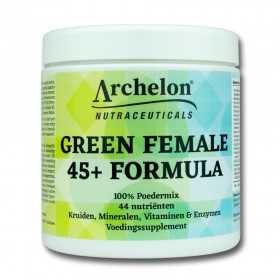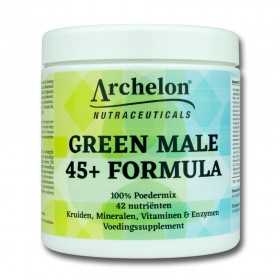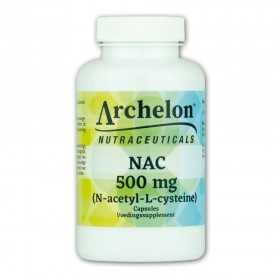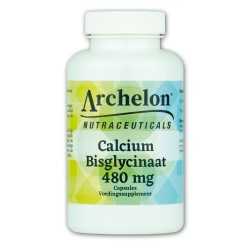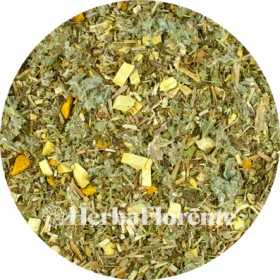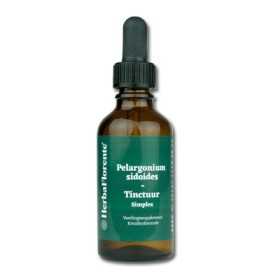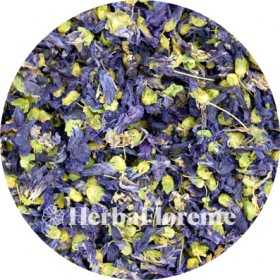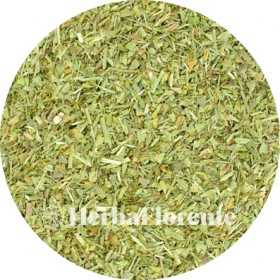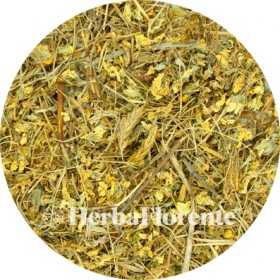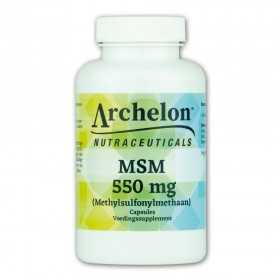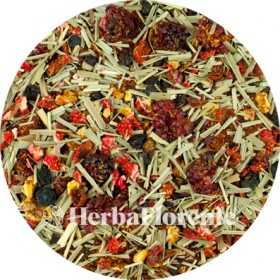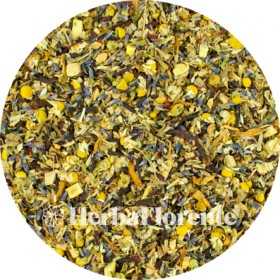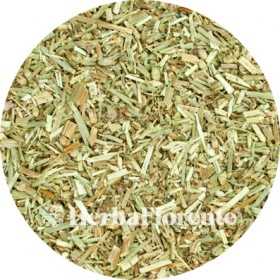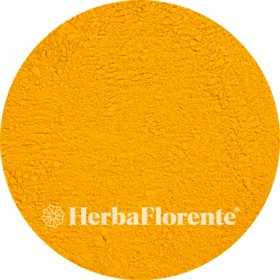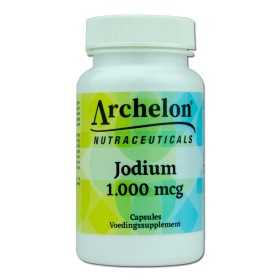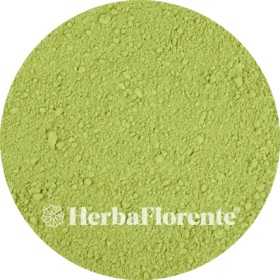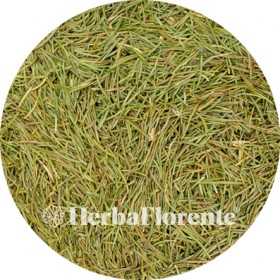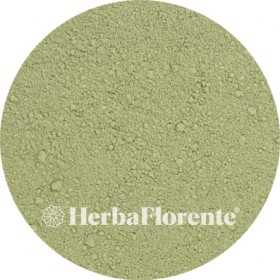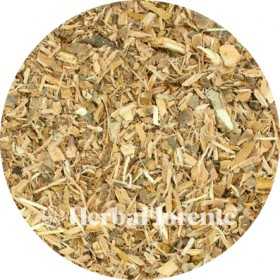Best sellers
There are 366 products.
Liver Stimulant Herbal Tea
Herbal tea composed of various herbs
Support for the Liver
Support for the Liver
€4.95
Geranium Tincture - Pelargonium sidoides Tincture
Single herbal tincture made with dried root of Pelargonium sidoides (Cape geranium).
The Cape geranium, also known as Pelargonium sidoides, is a South African geranium species that has been part of indigenous herbal lore for centuries. The locals call it 'umckaloabo'. This plant thrives in the wild among tall grass and aromatic flower beds on the slopes of the Cape coast. It has soft, velvety gray-green leaves and deep magenta-colored flowers. The dried and ground rhizomes are dark red in color. They have a soothing effect on the airways and are therefore suitable for providing support for airway problems.
The Cape geranium, also known as Pelargonium sidoides, is a South African geranium species that has been part of indigenous herbal lore for centuries. The locals call it 'umckaloabo'. This plant thrives in the wild among tall grass and aromatic flower beds on the slopes of the Cape coast. It has soft, velvety gray-green leaves and deep magenta-colored flowers. The dried and ground rhizomes are dark red in color. They have a soothing effect on the airways and are therefore suitable for providing support for airway problems.
€10.95
Heartwort Tincture - Leonurus cardiaca Tincture
Single herbal tincture made with dried herb of Leonurus cardiaca (Heartwort).
Heartwort (Leonurus cardiaca) is a fragrant perennial plant that belongs to the Lamiaceae family. Originating in Central Asia, this plant has spread throughout the world.
The leaves are suitable for seasoning pea and lentil soup, and were also used in the past to brew beer. This plant has been used for centuries for its medicinal properties for heart problems and muscle cramps.
The plant grows to a height of 30-90 cm and forms rhizomes and square stems with scattered hairs. The leaves, which are medium green in color, have three to seven lobes and are downy hairy on the underside.
Heartwort (Leonurus cardiaca) is a fragrant perennial plant that belongs to the Lamiaceae family. Originating in Central Asia, this plant has spread throughout the world.
The leaves are suitable for seasoning pea and lentil soup, and were also used in the past to brew beer. This plant has been used for centuries for its medicinal properties for heart problems and muscle cramps.
The plant grows to a height of 30-90 cm and forms rhizomes and square stems with scattered hairs. The leaves, which are medium green in color, have three to seven lobes and are downy hairy on the underside.
€10.95
Mallow Large - Malvacea Sylvestris
The flowers of mallow (Malva) are known for their natural wealth of mucilages, which have a soothing effect on the mucous membranes of the respiratory tract. Gargling with mallow tea can help with hoarseness and other throat complaints. In addition, mallow can be applied externally for eczema and ulcers.
Mallow belongs to the family Malvaceae and includes thirty species of herbaceous plants found in temperate, subtropical and tropical regions of Africa and Eurasia. The fruit of the mallow is a split fruit and owes its name to the flat, round shape, comparable to a cheese, due to the connected seeds.
Mallow belongs to the family Malvaceae and includes thirty species of herbaceous plants found in temperate, subtropical and tropical regions of Africa and Eurasia. The fruit of the mallow is a split fruit and owes its name to the flat, round shape, comparable to a cheese, due to the connected seeds.
€8.00
From: €8.00
Shepherds Purse - Capsella Bursa postoris
The shepherd's purse (Capsella bursa-pastoris) belongs to the cruciferous family (Brassicaceae).
It is an upright plant that can grow between 5 and 60 cm high, and is annual or biennial in nature. Shepherd's purse is winter hardy and usually has a lignified taproot. The sinuously toothed leaves form a rosette around the spindle-shaped root.
The plant is processed into various commercial products. In folk medicine, infusions are used against bleeding and inflammation of the urinary tract, and as a compress on open bleeding wounds. In addition, young rosette leaves can be used in salads or braised in soups.
It is an upright plant that can grow between 5 and 60 cm high, and is annual or biennial in nature. Shepherd's purse is winter hardy and usually has a lignified taproot. The sinuously toothed leaves form a rosette around the spindle-shaped root.
The plant is processed into various commercial products. In folk medicine, infusions are used against bleeding and inflammation of the urinary tract, and as a compress on open bleeding wounds. In addition, young rosette leaves can be used in salads or braised in soups.
€2.00
From: €2.00
Gentian (Yellow) - Gentiana lutea
The large yellow gentian, also known as Gentiana lutea, is a perennial plant belonging to the gentian family (Gentianaceae). This plant naturally occurs in European mountains, mainly at altitudes up to 2200 meters.
In ancient times, yellow gentian was used as a medicine against various ailments, including fever, gout, hypochondria, malaria, intestinal parasites and even alcoholism. Today the plant is mainly used for its bitter properties, such as stimulating the appetite, and as an ingredient in liqueurs, such as gentian liqueur.
In ancient times, yellow gentian was used as a medicine against various ailments, including fever, gout, hypochondria, malaria, intestinal parasites and even alcoholism. Today the plant is mainly used for its bitter properties, such as stimulating the appetite, and as an ingredient in liqueurs, such as gentian liqueur.
€4.80
From: €4.80
Pansy, Herb trinit (Flower) - Viola tricolor
Out-of-Stock
The pansy (Viola tricolor) belongs to the violet family (Violaceae) and is native to Europe, from Lapland to the Mediterranean, and even in Siberia.
This plant, which is an annual but can sometimes be perennial, grows to a height of 30 cm and has roots that can go up to 45 cm deep. The flowering period extends from May to October. The flowers are at least 1 cm wide, but usually larger, with an average diameter of 1.5 cm.
The pansy was first described as a medicinal herb by Rembert Dodoens in 1554. It was traditionally used for childhood diseases and respiratory diseases. In England it was popular for treating heart disease, chest cramps and pleurisy
This plant, which is an annual but can sometimes be perennial, grows to a height of 30 cm and has roots that can go up to 45 cm deep. The flowering period extends from May to October. The flowers are at least 1 cm wide, but usually larger, with an average diameter of 1.5 cm.
The pansy was first described as a medicinal herb by Rembert Dodoens in 1554. It was traditionally used for childhood diseases and respiratory diseases. In England it was popular for treating heart disease, chest cramps and pleurisy
€7.00
From: €7.00
MSM (Methylsulfonylmethane) - 550mg
MSM, full name methylsulfonylmethane, is an odorless, white crystalline powder that is soluble in water and is an important nutrient. It is an organic compound of sulfur that occurs both in our food and in our bodies. This compound, which naturally contains sulfur, plays an essential role in various body processes and is involved in the formation of more than 150 different substances.
The special thing about MSM is that it is a very easily absorbable form of sulfur. This compound contributes to the flexibility of the connections between cells, especially in tissues that naturally contain a lot of sulfur. Therefore, MSM can be beneficial for the hair, nails, joints, tendons, cartilage and ligaments.
The special thing about MSM is that it is a very easily absorbable form of sulfur. This compound contributes to the flexibility of the connections between cells, especially in tissues that naturally contain a lot of sulfur. Therefore, MSM can be beneficial for the hair, nails, joints, tendons, cartilage and ligaments.
€23.95
L-Tryptophan - 250 mg
Tryptophan is an essential amino acid, which means that the body cannot produce it itself and must therefore get it from food or supplementation. Tryptophan is found in meat, vegetables and fruit, among other things. Tryptophan is the only precursor of the neurotransmitter serotonin. Tryptophan also has several other functions.
€24.95
Echinacea (Red Coneflower) - 350 mg
Purple coneflower (Echinacea purpurea) is one of the most widely grown and used herbs in the world because of its positive influence on the immune system. The genus name 'echinacea' is derived from the Greek word 'echinos', meaning 'hedgehog', because of the spiky flower cone. Since the beginning of the last century, much research has been done into Echinacea purpurea in Europe.
This plant has a rich history and originally comes from North America. Indigenous tribes used this perennial plant for its beneficial effects on the immune system. Colonist doctor H.C.F. Meyer adopted this knowledge from the indigenous population and brought the first product based on echinacea onto the market in 1871.
This plant has a rich history and originally comes from North America. Indigenous tribes used this perennial plant for its beneficial effects on the immune system. Colonist doctor H.C.F. Meyer adopted this knowledge from the indigenous population and brought the first product based on echinacea onto the market in 1871.
€15.96
€19.95
Magnesium Bisglycinate - 500 mg
Magnesium bisglycinate is a high-quality form of magnesium, in which magnesium is bound to the amino acid glycine. Thanks to the small molecular structure of glycine, this form of magnesium is exceptionally well absorbed by the body, which ensures optimal biological availability. Magnesium bisglycinate not only supports the nervous system, but also contributes to healthy muscles and a balanced mental state. This makes it an excellent choice for those who want to promote their physical and mental well-being.
This easily absorbable form of magnesium is the ideal choice to take in the evening before going to sleep because it is bound to glycine. Glycine contributes to a better quality of sleep. Magnesium malate is the best choice to start the day with.
This easily absorbable form of magnesium is the ideal choice to take in the evening before going to sleep because it is bound to glycine. Glycine contributes to a better quality of sleep. Magnesium malate is the best choice to start the day with.
€25.95
Flu/Immune Herbal Tea
Herbal tea composed of various herbs
Support for flu and immune system
Support for flu and immune system
€3.95
Fruits Herbal Tea
Herbal tea composed of various herbs
Delicious for every moment
Delicious for every moment
€3.95
Relax Herbal Tea
Herbal tea composed of various herbs
Nice for a relaxing moment
Nice for a relaxing moment
€3.95
Chicory (Herb) - Cichorium Intybus
Chicory (Cichorium) belongs to the composite family (Compositae or Asteraceae) and includes well-known vegetables such as chicory and endive. It is mainly consumed for health reasons.
Since the late years of the twentieth century, chicory roots have been cultivated not only for chicory, but also for the production of inulin and sweeteners, especially fructose. Both inulin (a dietary fiber) and fructose are widely used in the food industry.
Roasted chicory root is used as a coffee substitute or as an ingredient in coffee brewing. In the past, this was done out of necessity, such as during the Napoleonic blockade during the French occupation.
Since the late years of the twentieth century, chicory roots have been cultivated not only for chicory, but also for the production of inulin and sweeteners, especially fructose. Both inulin (a dietary fiber) and fructose are widely used in the food industry.
Roasted chicory root is used as a coffee substitute or as an ingredient in coffee brewing. In the past, this was done out of necessity, such as during the Napoleonic blockade during the French occupation.
€2.00
From: €2.00
Bladderwrack Fine - Fucus vesiculosus
Bladderwrack (Fucus vesiculosus) is a type of brown algae belonging to the genus Fucus. It thrives along the northern coasts of the Atlantic and Pacific Oceans, and in the North Sea and Baltic Sea, often found in kelp forests. This seaweed is characterized by air bladders that serve as a floating organ, although there are also variants without these bladders.
Like other brown algae, bladderwrack is rich in a specific class of polyphenols called phlorotannins, which possess powerful antioxidant properties. In addition, these phlorotannins have antibiotic, antifungal and anti-inflammatory properties.
Like other brown algae, bladderwrack is rich in a specific class of polyphenols called phlorotannins, which possess powerful antioxidant properties. In addition, these phlorotannins have antibiotic, antifungal and anti-inflammatory properties.
€2.50
From: €2.50
Tumeric long. - Curcumae longae
Curcuma (also known as Turmeric) (Curcuma longa) is respected worldwide as one of the most valuable herbs. It originates in the tropical regions of India and Southeast Asia. The powder of the root is known for its popularity in Asian cuisine and is known in the Netherlands as turmeric, due to its role in coloring curry and mustard.
In addition to its culinary uses, turmeric also offers several health benefits. Curcuma has been used in India for centuries because of its effective effect on flexible joints and intestinal function. It is a powerful antioxidant that benefits the liver and musculoskeletal system, while also aiding digestion.
In addition to its culinary uses, turmeric also offers several health benefits. Curcuma has been used in India for centuries because of its effective effect on flexible joints and intestinal function. It is a powerful antioxidant that benefits the liver and musculoskeletal system, while also aiding digestion.
€2.00
From: €2.00
Blue Berrie - Vaccinium mytrillus, Frucus myrtilli
The blueberry (Vaccinium myrtillus) is not only nutritious, but also extremely popular. These berries are extremely low in calories and are often labeled as a superfood. Although low in calories, blueberries are packed with beneficial nutrients, including antioxidants like flavonoids and anthocyanins.
Additionally, they contain a wide range of other compounds, including folic acid, vitamins A and C, carotenoids, ellagic acid and fiber. The specific anthocyanins in blueberries contribute to normal eye function and provide support to the heart and blood vessels.
Additionally, they contain a wide range of other compounds, including folic acid, vitamins A and C, carotenoids, ellagic acid and fiber. The specific anthocyanins in blueberries contribute to normal eye function and provide support to the heart and blood vessels.
€8.20
From: €8.20
Cranberry Extract - 400 mg
Cranberries naturally contain anthocyanins, pigments that are responsible for the striking red color of these berries. Anthocyanins belong to the flavonoids, also called bioflavonoids, and are found in vegetables, fruit, herbs and other plants.
They come in different colors and fulfill various important functions in the metabolism of plants. They help protect the plant, regulate growth, and provide protection against UV light, oxidation and heat.
Cranberries are known not only for their tangy flavor and vibrant color, but also for their impressive nutritional value and health benefits. These small, red berries are packed with vitamins, minerals and antioxidants, including the aforementioned anthocyanins.
They come in different colors and fulfill various important functions in the metabolism of plants. They help protect the plant, regulate growth, and provide protection against UV light, oxidation and heat.
Cranberries are known not only for their tangy flavor and vibrant color, but also for their impressive nutritional value and health benefits. These small, red berries are packed with vitamins, minerals and antioxidants, including the aforementioned anthocyanins.
€34.95
Iodine - 1,000 mcg
Iodine is an essential element that is important for the synthesis of thyroid hormones. Iodine contributes to energy metabolism, among other things by supporting enzymes involved in this. Iodine also contributes to normal cognitive functions, the nervous system and the skin, among other things.
€29.95
Field Horsetail - Equisetum arvense
Horsetail (Equisetum arvense), also known as horsetail because of its appearance, belongs to the horsetail family. It is known for its supportive properties for the skin, hair and nails, and it provides benefits for the liver and blood vessels. Horsetail extract has a natural calming effect and promotes a healthy moisture balance.
This plant thrives in different environments, such as meadows, along roads, on waste land and on slopes. Horsetail is one of the oldest plant species on earth, having existed for 390 million years. Thanks to its deep roots, horsetail can extract minerals from the depths of the earth. That is why horsetail is packed with valuable substances, including minerals, fiber and silicon.
This plant thrives in different environments, such as meadows, along roads, on waste land and on slopes. Horsetail is one of the oldest plant species on earth, having existed for 390 million years. Thanks to its deep roots, horsetail can extract minerals from the depths of the earth. That is why horsetail is packed with valuable substances, including minerals, fiber and silicon.
€4.75
From: €4.75
Spruce - Picea Abies
The Norway spruce (Picea abies) belongs to the pine family (Pinaceae) and is native to Northern and Central Europe. It is an imposing conifer that can grow up to 50 meters high.
This tree is monoecious and has a narrow, cone-shaped crown. Spruce trees that grow at lower elevations tend to have wider crowns to be less affected by snow accumulation. The twigs are reddish to orange-brown, while the buds are smooth, brown and pointed. The needles are dark green on all sides and surround the twigs. They are stiff, sharply pointed, square in cross-section and can grow 1 to 2.5 cm long. The lifespan of the needles can be up to 5 to 7 years.
This tree is monoecious and has a narrow, cone-shaped crown. Spruce trees that grow at lower elevations tend to have wider crowns to be less affected by snow accumulation. The twigs are reddish to orange-brown, while the buds are smooth, brown and pointed. The needles are dark green on all sides and surround the twigs. They are stiff, sharply pointed, square in cross-section and can grow 1 to 2.5 cm long. The lifespan of the needles can be up to 5 to 7 years.
€2.00
From: €2.00
Ribwort Plantain - Plantaginis lanceolata
Ribwort Plantain (Plantago lanceolata) is a native plant that thrives in Europe, parts of Asia, North Africa and North America. The young leaves of this plant contain a rich mix of beneficial substances, including mucilages, tannins, bitter substances, flavonoids and minerals such as potassium and zinc. Best known for its soothing effect on the throat thanks to its mucilages, plantain also provides support for the immune system and promotes normal intestinal function. In addition, it can help maintain flexible joints and is beneficial for the liver.
€2.40
From: €2.40
copy of Witch Hazel (Bark) - Hamamelis virginiana
The American witch hazel (Hamamelis virginiana) is a shrub belonging to the family Hamamelidaceae, native to North America from Nova Scotia to Minnesota, and from southern and central Florida to eastern Texas.
The shrub can reach a height of 6 to sometimes even 10 meters, with a bushy growth thanks to the many branches that arise just above the ground. The bark is light brown, smooth but somewhat flaky, and shows a reddish-purple color on the inside.
Blooming from September through October, the flowers of the American witch hazel display clusters of 4 stamens. They usually range from pale yellow to bright yellow, although orange or red hues also occur. The petals are ribbon-shaped and measure 10-20 mm in length.
The shrub can reach a height of 6 to sometimes even 10 meters, with a bushy growth thanks to the many branches that arise just above the ground. The bark is light brown, smooth but somewhat flaky, and shows a reddish-purple color on the inside.
Blooming from September through October, the flowers of the American witch hazel display clusters of 4 stamens. They usually range from pale yellow to bright yellow, although orange or red hues also occur. The petals are ribbon-shaped and measure 10-20 mm in length.
€5.20
From: €5.20








